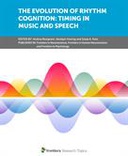Explore

The Evolution of Rhythm Cognition: Timing in Music and Speech
0 Ungluers have
Faved this Work
Login to Fave
Human speech and music share a number of similarities and differences. One of the closest similarities is their temporal nature as both (i) develop over time, (ii) form sequences of temporal intervals, possibly differing in duration and acoustical marking by different spectral properties, which are perceived as a rhythm, and (iii) generate metrical expectations. Human brains are particularly efficient in perceiving, producing, and processing fine rhythmic information in music and speech. However a number of critical questions remain to be answered: Where does this human sensitivity for rhythm arise? How did rhythm cognition develop in human evolution? How did environmental rhythms affect the evolution of brain rhythms? Which rhythm-specific neural circuits are shared between speech and music, or even with other domains? Evolutionary processes’ long time scales often prevent direct observation: understanding the psychology of rhythm and its evolution requires a close-fitting integration of different perspectives. First, empirical observations of music and speech in the field are contrasted and generate testable hypotheses. Experiments exploring linguistic and musical rhythm are performed across sensory modalities, ages, and animal species to address questions about domain-specificity, development, and an evolutionary path of rhythm. Finally, experimental insights are integrated via synthetic modeling, generating testable predictions about brain oscillations underlying rhythm cognition and its evolution. Our understanding of the cognitive, neurobiological, and evolutionary bases of rhythm is rapidly increasing. However, researchers in different fields often work on parallel, potentially converging strands with little mutual awareness. This research topic builds a bridge across several disciplines, focusing on the cognitive neuroscience of rhythm as an evolutionary process. It includes contributions encompassing, although not limited to: (1) developmental and comparative studies of rhythm (e.g. critical acquisition periods, innateness); (2) evidence of rhythmic behavior in other species, both spontaneous and in controlled experiments; (3) comparisons of rhythm processing in music and speech (e.g. behavioral experiments, systems neuroscience perspectives on music-speech networks); (4) evidence on rhythm processing across modalities and domains; (5) studies on rhythm in interaction and context (social, affective, etc.); (6) mathematical and computational (e.g. connectionist, symbolic) models of “rhythmicity” as an evolved behavior.
This book is included in DOAB.
Why read this book? Have your say.
You must be logged in to comment.
Rights Information
Are you the author or publisher of this work? If so, you can claim it as yours by registering as an Unglue.it rights holder.Downloads
This work has been downloaded 552 times via unglue.it ebook links.
- 197 - mobi (CC BY) at Unglue.it.
- 185 - epub (CC BY) at Unglue.it.
- 170 - pdf (CC BY) at Unglue.it.
Keywords
- beat perception
- evolution of cognition
- evolution of speech and language
- interval timing
- meter
- Movement
- Music
- Rhythm
- Speech
- synchrony
- thema EDItEUR::P Mathematics and Science::PS Biology, life sciences::PSA Life sciences: general issues::PSAN Neurosciences
- Time perception
Links
DOI: 10.3389/978-2-88945-500-3Editions

